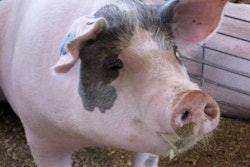
Nutrient requirements of modern genotype pigs are well researched. Still, many pigs don’t reach their performance potential, despite carefully formulated diets. This can be due to management and/or environmental factors. But there are also nutritional factors that we have less control over. They can lead to a whole host of stress reactions in the animal and sub-optimal efficiency in performance of the pig. The fact is the pig will be subjected to stressors throughout its productive life.

Pigs have many negative reactions in response to stressors.
There is scientific evidence suggesting that for genetic selection, improving the ability of pigs to cope with stressors may be a better way of improving pig performance than selecting only for increased growth potential. Therefore, increasing the pig’s capability to adapt to stressors more adequately by nutritional means also offers an alternative to improved pig performance. Most importantly, the ability of the animal to deal with the stressors will also impact the return on investment (ROI) of diet formulations and profitability of the producer.
Attack nutritional stressors
Traditionally, feed additives have been developed to attack potential stressors in the animal’s digestive tract directly. For instance, enzymes degrade specific non-digestible components such as phytate and non-starch polysaccharides (NSPs) in the pig to release trapped nutrients and also reduce the potential negative side effects of those components. What about less digestible components in feed that are not specifically targeted by feed enzymes?
Antibiotic growth promotors have been used for their anti-bacterial effect against certain pathogenic bacteria. But in many countries antibiotics have already been banned from the routine use in animal feed. More countries are following suit, and there is a greater need for effective alternatives.
The agile gut helps the animal adapt to stressors more efficiently and be more robust in the face of dietary challenges and stressors.
Mycotoxin binders and mycotoxin deactivators are being applied to diets to counteract harmful effects from mycotoxins in the animal. However, it is well known that adsorption is not an effective strategy for all mycotoxins. Biotransformation of mycotoxins into non-toxic metabolites will only target certain types of mycotoxins and is unlikely to be complete in the animal’s digestive tract.
Adapt to nutritional stressors
The question is, how does the animal deal with the stressors left untouched by the highly specific feed solutions mentioned above? The pig needs to become more agile. As mentioned above, greater results in pig performance can be achieved by improving the pig’s ability to cope. That means the pig needs to be able to adapt faster and more adequately to dietary changes and stress factors for efficient performance. Genetic selection is certainly going to play an important role for advancement in this capability of the pig. Nutritional strategies supporting the speed and efficacy with which the pig adapts to stressors will bring a more immediate competitive advantage in pig production.
Agility in business
When the measure of performance is profitability, a few large companies in every industry consistently outperform their peers over extended periods. And they maintain this advantage even in the face of significant business change in their competitive environments. The one factor they have in common is agility — they adapt successfully. Agility is a capability that enables an organization to respond in a timely, effective and sustainable way when changing circumstances require it. Research conducted at the Massachusetts Institute of Technology suggests that agile companies generate 30 percent higher profits than non-agile companies. Another survey identified greater efficiency as a significant benefit of greater organizational agility.

Greater organizational agility leads to better business performance.
Gut agility in pigs
Applying the concept of agility to the pig can help to further develop efficiency in pig production. The gut and the immune system are particularly responsive to stressors, hence why the emphasis is on the gut when improving the animal’s adaptive response. Gut agility is a new term coined to describe the pig’s ability to adapt to nutritional stressors in a faster and more energy-efficient response than it normally would.
What works
As plants evolved they developed very sophisticated coping mechanisms to stressors and potential threats to improve survival. They contain a multitude of bioactive substances, with a variety of properties such as anti-oxidant, anti-inflammatory, anti-microbial, anti-viral and aromatic. The combination of the many substances makes plants polyvalent to different stressors. It is therefore only natural to think of applying plant extracts to nutritional strategies developed to empower pigs to adapt to stressors. Substances derived from plants have already proven to be highly effective in nature, helping plants to be more agile in the face of stressors and threats to survival. However, the speed of gut agility, supported by bioactive substances in the feed, will depend on finding the optimal combination suited to the pig and its challenges.
Conclusions
Combining nutritional strategies with relevant genetic selection parameters to enhance the agility of the pig gut could contribute to safer and more profitable meat production in the face of increasing consumer pressure for antibiotic-free diets.















